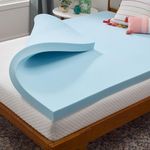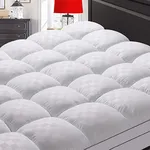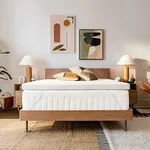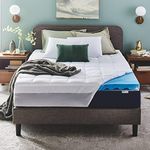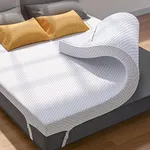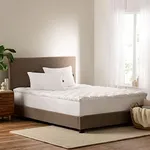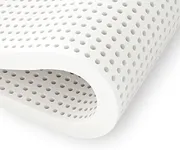Buying Guide for the Best Mattress Topers
Choosing the right mattress topper can significantly improve your sleep quality and comfort. A mattress topper is an additional layer that sits on top of your mattress to provide extra cushioning, support, and sometimes even temperature regulation. When selecting a mattress topper, it's important to consider various factors that will affect your sleep experience. Here are some key specifications to look at and how to navigate them to find the best fit for you.MaterialThe material of a mattress topper is crucial as it determines the feel, support, and durability. Common materials include memory foam, latex, down, and wool. Memory foam offers excellent contouring and pressure relief, making it ideal for those with joint pain. Latex is more resilient and provides a bouncy feel, suitable for those who prefer a firmer surface. Down and wool toppers are softer and provide natural temperature regulation, perfect for those who want a plush feel and tend to sleep hot or cold. Choose a material based on your comfort preference and any specific needs like pain relief or temperature control.
ThicknessThickness affects the level of cushioning and support a mattress topper provides. Toppers typically range from 1 to 4 inches thick. A thinner topper (1-2 inches) adds a slight layer of comfort without drastically changing the feel of your mattress, suitable for minor adjustments. Medium thickness (2-3 inches) offers a balance of comfort and support, ideal for most sleepers. Thicker toppers (3-4 inches) provide significant cushioning and can help rejuvenate an old mattress, perfect for those needing extra support or who have a very firm mattress. Consider your current mattress condition and how much change you want in your sleep surface.
DensityDensity refers to how compact the material is within the topper, affecting its firmness and durability. Higher density toppers (4-5 lbs per cubic foot for memory foam) are firmer and more durable, providing better support and longevity, suitable for heavier individuals or those needing more support. Lower density toppers (2-3 lbs per cubic foot) are softer and more plush, ideal for lighter individuals or those preferring a softer sleep surface. Choose a density based on your weight, preferred firmness, and how long you want the topper to last.
Temperature RegulationTemperature regulation is important for maintaining a comfortable sleep environment. Some toppers come with cooling gel, breathable materials, or phase-change technology to help dissipate heat. Memory foam can retain heat, so look for options with cooling features if you tend to sleep hot. Natural materials like wool and latex are inherently breathable and can help regulate temperature. Consider your typical sleep temperature and choose a topper that will help keep you comfortable throughout the night.
Allergen ResistanceAllergen resistance is important for those with allergies or sensitivities. Some materials, like latex and wool, are naturally resistant to dust mites and other allergens. Memory foam and synthetic materials can also be treated to resist allergens. If you have allergies, look for hypoallergenic options to ensure a healthier sleep environment. Choose a topper that will help minimize your exposure to allergens and improve your overall sleep quality.
Ease of MaintenanceEase of maintenance refers to how easy it is to clean and care for your mattress topper. Some toppers come with removable, washable covers, which can be convenient for keeping your sleep surface clean. Others may require spot cleaning or professional cleaning. Consider how much effort you're willing to put into maintaining your topper and choose one that fits your lifestyle. A topper with a washable cover can be a good choice for those who want easy maintenance.
